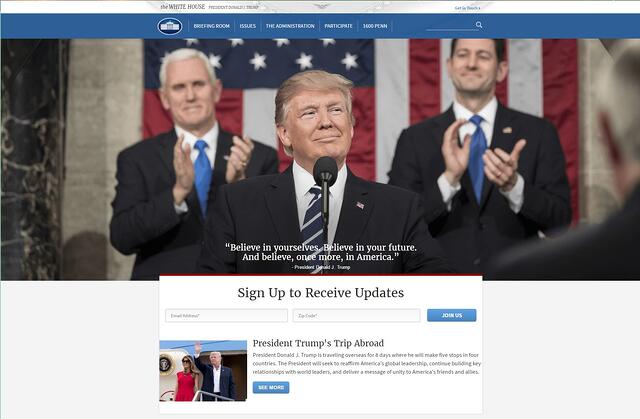Shortly after U.S. President Donald Trump took office the Spanish language resources on the official White House website were eliminated. Some say the White House will eventually restore the Spanish pages. They also point out that the old pages from when Barack Obama was President are still available. But now, more than five months into the new administration, if you prefer to communicate in Spanish you’re out of luck at the White House official website.

Other federal government entities do provide Spanish language websites. A recent example is the Immigration and Customs Enforcement (ICE). Its Spanish site launched on May 15th. The translated site offers information about ICE and the agency’s mission, as well as press releases and special features.
“Offering information in other languages helps ICE communicate across cultures and reach a broader audience,” says Liz Johnson, Assistant Director of Public Affairs at ICE, “while also ensuring that the public can obtain information directly from ICE, and not from unofficial – and possibly unscrupulous – sources.”

Spanish Growing In Importance
But while the White House site offers no Spanish translation, U.S. businesses are well aware of the growing importance of communicating in Spanish. Translation services continue to be one of the United States’ fastest growing occupations, partially because of business needs and the nation’s changing demographics:
- Approximately 54 million Hispanics lived in the US in 2013, according to Pew Research Center
- Hispanics today make up 17 percent of the US population
- The U.S. Census Bureau projects that by 2060 the Hispanic population will account for 28.6 percent of the population
Globalization is also leading to more need for Spanish language services. More and more U.S. companies are becoming multinational and expanding into Spanish-speaking markets. In general, the world population is gaining wealth so the opportunities for business and commerce are increasing. Of course, there’s also the need for Spanish translations of critical and life-saving material especially in the medical and legal fields.
The fact that the translation industry is thriving demonstrates the ever-increasing value of professional translation services — in the U.S. that’s especially true for the Spanish language. As reported by The Charlotte Observer, experts say, “Translators’ relative immunity to the nation’s economic downturn highlights the growing demand for multilingual speakers in an increasingly globalized economy.”
Many U.S. businesses recognize the need for more and high quality translation services because of facts and statistics like these:
- Hispanic buyers outspend non-Hispanics on groceries, candy, and electronics
- 56 percent of Spanish-dominant Hispanics agree that, “When I hear a company advertise in Spanish, it makes me feel like they respect my heritage and want my business,” according to the Experian Simmons Summer 2011 National Hispanic Consumer Study
- 54 percent of Spanish-dominant Hispanics feel “much more loyal to companies that show appreciation of our culture by advertising in Spanish,” the same study found.

Translation Need Strong for French, German, Chinese, and Other Languages
In the near future, the demand for frequently translated languages such as French, German, Italian, Portuguese and Spanish will remain particularly strong. The most widely used Asian languages such as Chinese, Japanese, and Korean will also remain in high demand. Arabic and other Middle Eastern languages will rank in third position. In the 21st century, businesses and governments must communicate and publish regularly (often in several languages) with existing and potential customers, business partners, and employees working in other countries.
More than 82 percent of Hispanic U.S. adults say they speak Spanish. Studies by the Pew Hispanic Center show that 95 percent of them say it’s important for future generations to continue to do so. That means that while an increasing number of U.S. Hispanics are bilingual (currently 51 percent), reaching out to U.S. Hispanics in Spanish is important.
U.S. Hispanic Market at $1.3 Trillion
The $1.3 trillion U.S. Hispanic market is larger than the entire economies of all but 13 countries in the world. And that market is set to grow by 50 percent in the next five years.
Whether or not the White House website returns to offering Spanish translations, the trend is clear. The U.S. future holds more (not less) need for Spanish translation and interpretation.
We would love to hear your thoughts on this trend in the comments below!
Other iTi posts that deal with similar issues include:
Are Governments Wasting Money On Translation?






Comments are closed here.